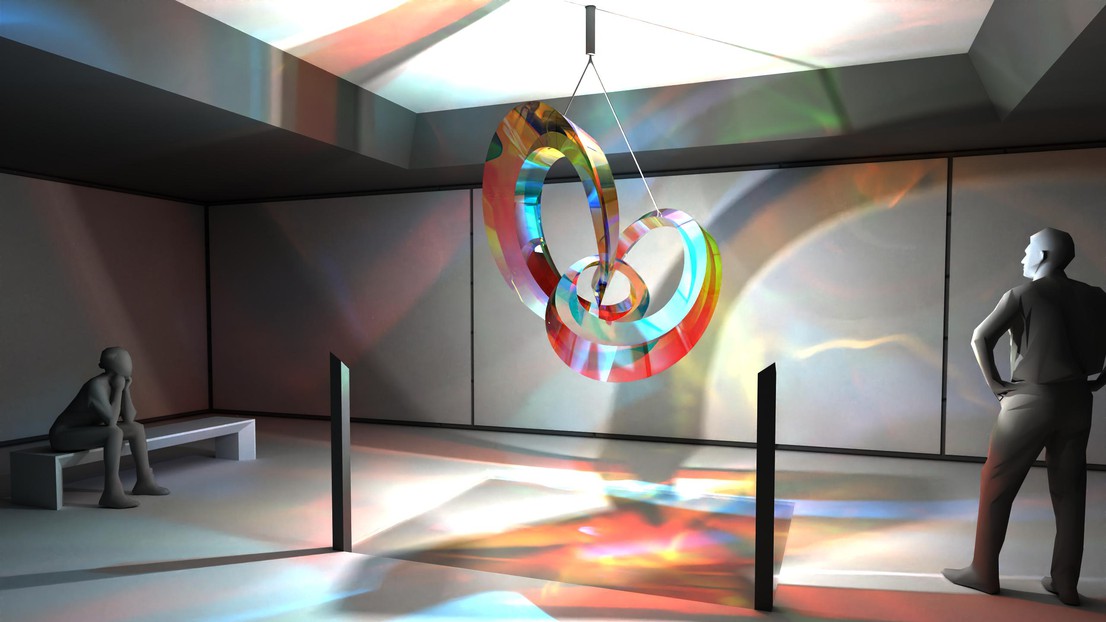
C-Tube mold casting. 2025 EPFL - CC-BY-SA 4.0
EPFL researchers have developed a new way to design complex, curved three-dimensional shapes using flat materials such as paper, aluminum sheets or plastic, combining creative thinking with a new computational algorithm.
Have you ever rolled a piece of paper into a cylinder, or tried to wrap aluminum foil around an object without making it crumple? Imagine being able to simply turn a piece of flat material into beautiful, strong furniture, lighting or even the buildings and bridges of the future.
In the world of architecture and product design this idea of building complex 3D shapes using flat materials has always been a fascinating challenge. Flat sheets made from materials such as paper, metal, or plastic are easy to cut and manipulate, but until now, turning them into specific curved shapes has required clever engineering and design, expensive shaping tools and often a lot of trial and error.
C-Tubes
Enter C-Tubes, a new way to build curved, tubular structures using flat strips that bend without stretching or wrinkling, developed by researchers from the Geometric Computing Laboratory (GCM) part of EPFL's School of Computer and Communication Sciences (IC). Their paper, C-Tubes: Design and Optimization of Tubular Structures Composed of Developable Strips, was presented this week at the ACM SIGGRAPH 2025 Conference, receiving the Best Paper honorable mention.
"In architecture, engineering and design, surfaces you can make from flat sheets of material are called developable. A sheet of paper, for example, can be rolled into a cylinder or a cone without damaging it," explained Klara Mundilova, a post-doctoral researcher at GCM. "Designing with developable surfaces is tricky-most methods require careful tuning to avoid creases or distortions. We take a different route and assemble parts that are developable by construction," she continued.
The researchers came up with a system where they cut flat strips from a sheet, then bend and connect them to form closed tubes that curve, twist, and loop in space. These C-Tubes are surprisingly stiff and strong, even though they're made from materials that are flexible before assembly.
Behind this simplicity lies elegant mathematics, and the underlying geometric concepts open up exciting new possibilities for designing and building with flat materials.
Design With Sustainability
"We developed an algorithm that determines how to design objects that can be assembled from flat pieces that can be cut, bent, and then joined together. Our algorithm adjusts the input parameters so that the final shape matches the designer's goal and is guaranteed to work as a physical object," said Michele Vidulis, PhD student at GCM. "In the end, we intend to relieve designers from worrying about fabrication so that they can focus on aesthetics and function," said Quentin Becker, also a post-doctoral researcher at GCM.
This is an important development because one of the biggest challenges in design is making sure that a shape is actually buildable. That is, when you try to force a flat material into a complex shape after designing it, it often ends up wrinkled or torn, because the surface wasn't designed with real-world materials in mind.
The new algorithm analyzes the geometry and structure of possible C-Tube shapes, automatically building them in a way that guarantees all their parts are developable. New mathematical insights are complemented by numerical optimization to tweak the shape so that it matches the designer's goals. This means that designers can be faster, and more creative with their designs, focusing on shapes that will be easy to build. But there are other benefits to C-Tubes and the new algorithm as well.
"It's a more sustainable production process than traditional manufacturing. There is less waste compared to carving or molding methods, and because C-Tube structures are lightweight with an excellent stiffness, less material is needed overall. This also saves energy during production, and flat materials are often easier to source, transport, and recycle," said Florin Isvoranu, an architect with the Geometric Computing Laboratory.
Will C-Tubes Revolutionize Design and Architecture?
C-Tubes can be applied to almost any 3D design where strength and lightness matter. Already, as part of their ongoing work, the researchers have designed furniture, including a rocking chair, and a prototype lamp.
Looking ahead, they can imagine applications in the architecture of buildings, large roof structures or domes, ship hulls or automotive design - all curved shapes that are currently difficult to build. As with many industries, one challenge to overcome will be the inertia for adoption.
"C-Tubes can dramatically reduce the design time for objects and contribute to more sustainable products, but innovation can be challenging in these fields. People already have huge tool sets at their disposal. We want to show that it's possible to create more interesting things without raising the complexity of production and we'd love to find a partner who would like to use this technology to build something with us!" said Professor Mark Pauly, head of GCM.
Overall, Pauly concludes, C-Tubes has been a dream project to work on with an interplay between materiality, design and elegant mathematics.
"We've moved between making real objects and figuring out the math behind them. I find fascination in several aspects of this. The beauty and physicality of the prototype lamp that we created amazes me and I find the mathematical side just as beautiful. There's an elegance to the intersection of all this - interesting theory, powerful algorithms and then a technique to physically produce things."






